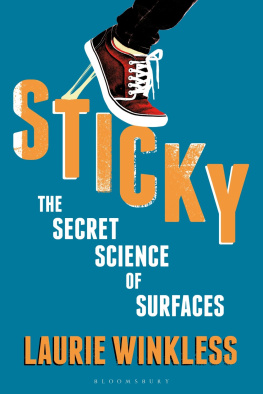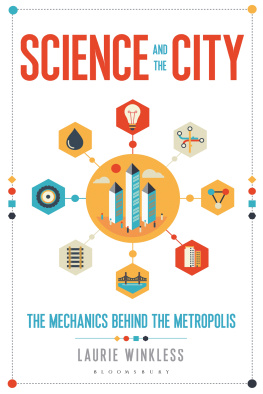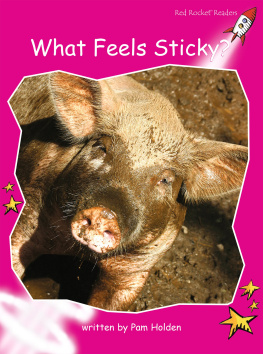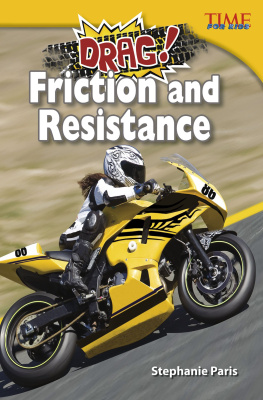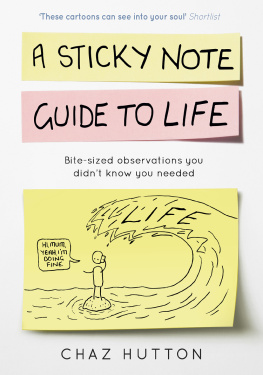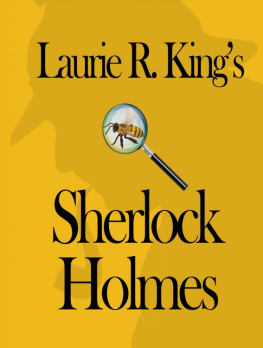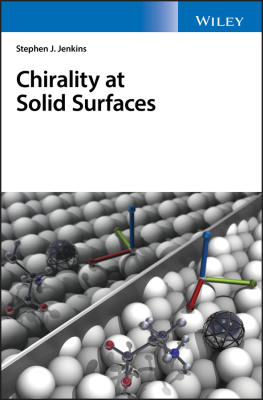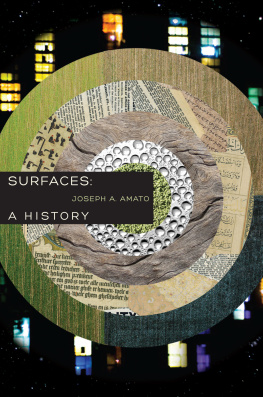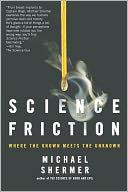A NOTE ON THE AUTHOR
Laurie Winkless is an Irish physicist and author. After a physics degree and a masters in space science, she joined the UKs National Physical Laboratory as a research scientist, specialising in functional materials. Now based in New Zealand, Laurie has been communicating science to the public for 15 years.
Since leaving the lab, Laurie has worked with scientific institutes, engineering companies, universities, and astronauts, among others. Her writing has featured in outlets including Forbes, Wired, and Esquire, and she appeared in The Times magazine as a leading light in STEM. Lauries first book was Science and the City, also published by Bloomsbury.
@laurie_winkless
Some other titles in the Bloomsbury Sigma series:
Sex on Earth by Jules Howard
Spirals in Time by Helen Scales
A is for Arsenic by Kathryn Harkup
Suspicious Minds by Rob Brotherton
Herding Hemingways Cats by Kat Arney
The Tyrannosaur Chronicles by David Hone
Soccermatics by David Sumpter
Science and the City by Laurie Winkless
The Planet Factory by Elizabeth Tasker
Turned On by Kate Devlin
Borrowed Time by Sue Armstrong
The Vinyl Frontier by Jonathan Scott
Clearing the Air by Tim Smedley
Superheavy by Kit Chapman
The Contact Paradox by Keith Cooper
Life Changing by Helen Pilcher
First Light by Emma Chapman
Models of the Mind by Grace Lindsay
Handmade by Anna Ploszajski
Beasts Before Us by Elsa Panciroli
Our Biggest Experiment by Alice Bell
Aesops Animals by Jo Wimpenny
Fire and Ice by Natalie Starkey
Racing Green by Kit Chapman
Wonderdog by Jules Howard
Growing Up Human by Brenna Hassett
Wilder by Millie Kerr
Superspy Science by Kathryn Harkup
To Richard. For holding my hand through everything.

Contents
This book might only have one name on the front cover, but without the wonderful humans listed below, it would never have happened. If you gave up your time to help me in any way, I owe you a debt.
Those I interviewed and quoted: Monique Parsler, Colin Gooch, Gabriel Nodea, Marcelle Scott, Steven Abbott, Adrian Lutey, Kellar Autumn, Alyssa Stark, Mark Cutkosky, Arul Suresh, Aaron Parness, Amy Kyungwon Han, Fiona Fairhurst, Melissa Cristina Mrquez, Dylan Wainwright, Bodil Holst, Maz Jovanovich, Andrew Neely, Priyanka Dhopade, Jon Marshall, Gemma Hatton, Shahriar Kosarieh, John Carey, Carolyn Boulton, Laura Wallace, Jeremy Gosselin, Rob Langridge, Emily Warren-Smith, Daniel Bonn, Mark Shegelski, Staffan Jacobson, Mark Callan, Christina Hulbe, Amy Betz, Gilane Khalil, Tanja Van Peer, Matt Carr, Sile OModhrain, Heather Culbertson, Lenice Evergreen, Nina Wronski, Ashlie Martini, Philip Moriarty, Jeffrey L. Streator.
Those who advised me, talked about their work, introduced me to others, lined up interviews, sent me reports, papers, images and data, or fact-checked my ramblings: Geoff Wilmott, Chiara Neto, Emile Webster, Jenny Malmstrm, the team at NZ Police (Matt, Eugene, Tony and Greg), James Batteas, Dan Bernasconi, Wilhelm Bathlott, Alex Russomanno, Rachel Oliver, Alan Baxter, Hannah Davidson, Geoff Kilgour, Robyn Sloggett, Zh Creative, Will Hings, Bettina Mears, Maggie McArthur Murray, Vanessa Young, Jim Sutton Charles Dhong, Mark Lincoln and Adam Parr.
My chapter reviewers: Lisa Martin, John Uhlrich, Eleanor Schofield, Laura Sessions, Paul Byrne, Clare Bardsley, Leanne Ross, David Lamb, Nic Harrigan, Celeste Skatchill, Catherine Qualtrough, Rebecca OHare, Anna Sampson, Gareth Hinds, Felicity Powell, @ThatMaoriGirl, Nicola Hardy, Claire Lucas, Orla Wilson, John Englishby.
My husband, whose patience is unmatched, and who has lived through every single word of this book. My parents and family who never doubted that Id eventually finish writing it, and who tell me that theyre proud of me, even when Im a mess. My friends, scattered across multiple timezones, who are my main source of moral support and welcome distraction, especially when things are wobbly. My Sigma-siblings for continuously lifting me up. My Twitter-fam and occasional friendly stranger for basically being my colleagues, cheerleaders and confidants. And Mary Roach for giving me the thumbs-up to use a book title that she inspired.
And finally, a big thanks to the team at Bloomsbury , especially Sigma-Daddy Jim Martin, who didnt shout at me when I moved to the other side of the world, nor when I told him the book was going to be >1.5 years late. Catherine Best and Marc Dando for helping to turn a rough draft into something worth publishing. Anna MacDiarmid who set Sticky on its long path, and Angelique Neumann who carried it home.
Thank you all x
Theres a flowchart lurking around corners of the internet. It is familiar to anyone who enjoys fixing and making things. At the top, it asks Does It Move? and at the bottom, it offers two solutions: duct tape for when you want to hold something in place, and WD-40 for when you want to get things moving. These two products have long been seen as must-haves. Essential tools for any workshop; versatile enough to find frequent use. Im a fan of both.
A few years ago, as the initial idea for this book was rattling around in my head, I realised something about these products. Because one sticks firmly on to surfaces, while the other slips between objects in order to loosen them, theyre often viewed as opposites; as if they each occupy an end point of a stickiness-to-slipperiness scale. In reality, no such scale exists not in our everyday lives, nor in the controlled environment of a research lab. Thats because the words sticky and slippery are ambiguous, and certainly not precise enough to exist in opposition to one another. Though widely used, they mean different things to different people on different days. Depending on the situation, they might conjure up images of chewing gum, duct tape and sugary syrup on the one hand, or an icy road, WD-40 and wet tiles on the other. The words sticky and slippery are also not true materials properties in the way that, say, hardness and thermal conductivity are. They have no agreed-upon scientific definitions, and no specific metrics that can be used to quantify or compare them. That contrast between the presence of these words in daily life,

Figure 1: The engineering flowchart lurking around the internet.
As I see it, this familiar term can be repurposed and applied to a vast array of interesting interactions: specifically, any of the weird and wonderful things that happen on and between surfaces. So much science happens where two things meet; whether thats air flowing over a curved surface, two pieces of metal sliding along one another, or glue applied to a plank of wood. And while stickiness isnt something that can be measured or defined, there are lots of other related properties that are measurable, and whole areas of research dedicated to defining them.
Tribology is one of these areas.glaciers on rocky landscapes and the whizzing of a hard-disk drive in your computer. Regardless of the sector they work in, something all tribologists are obsessed with is friction , the resistive force that acts parallel to surfaces, either to hold stationary objects in place (static friction) or to slow down the motion between those that move (kinetic friction).

